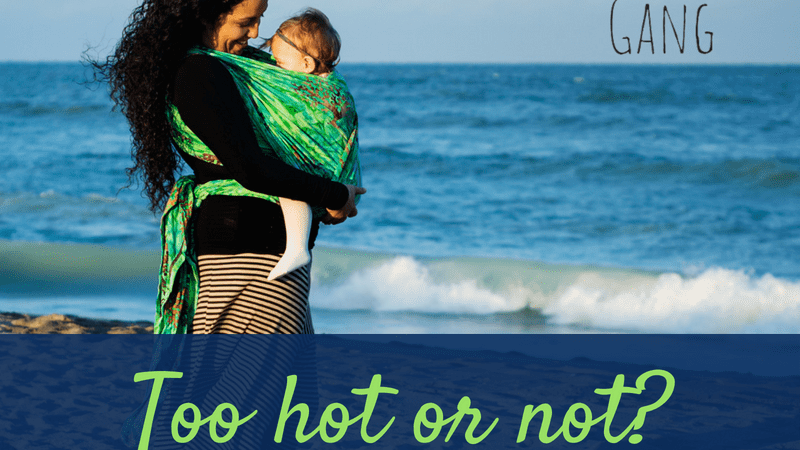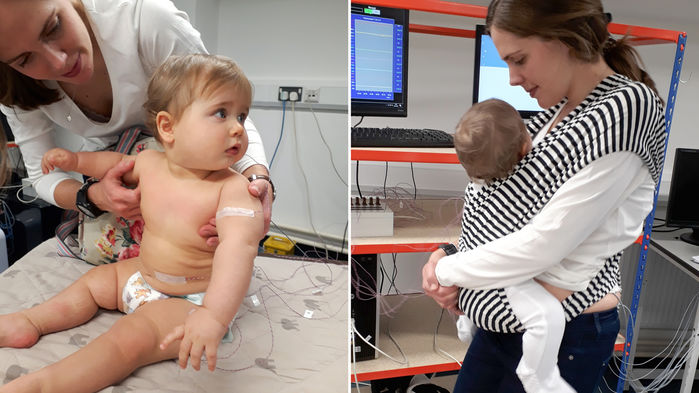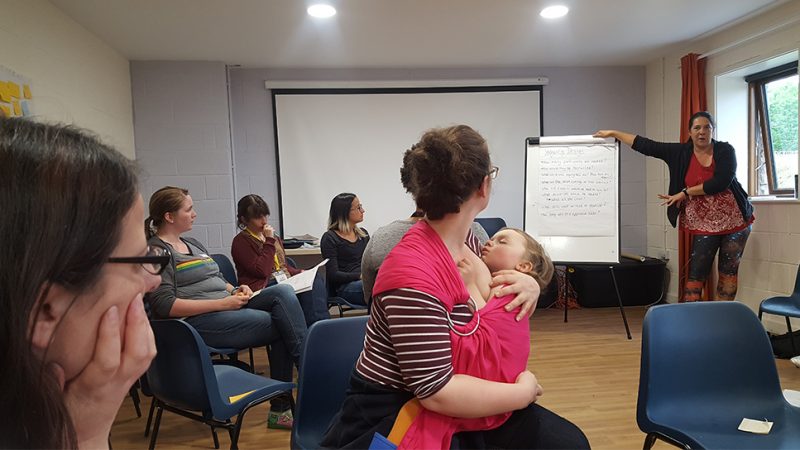
How hot is my baby in a carrier?
An citizen science experiment by the Science-Aware Natural Parenting Science Gang
There are so many rules to live by when you’re a new parent, but it can be hard to tell what is based in fact and what is not. For many parents who use baby carriers, there is an oft-heard phrase – baby should be in one more layer of clothing than the adult and the baby carrier is that layer. Straight away, this causes confusion – carriers come in so many different materials and thicknesses – how do you know how many layers your carrier counts for? How hot do babies get in carriers?
The Science-Aware Natural Parenting Science Gang group set out to find what information was out there and what experts might help us learn. Turns out, this is one rule not well tested, especially when it comes to baby carriers specifically. In fact we quickly discovered that while there is some research into temperature regulation for skin to skin practice and in kangaroo care for premature babies, when it comes to full-term, healthy infants, there is very little research into how our own body heat affects infants in carriers.
It also turns out that measuring baby temperatures exactly is an especially difficult thing to do and there are not a lot of labs set up for such precise measurements. Enter Dr Davide Fillingeri, a lecturer at the Loughborough University. He runs a lab that investigates temperature and the human body. When we presented the question to him, he was excited to see what we could find and was convinced his lab equipment would be able to answer the question.
With Davide’s support, we designed an lab-based experiment to look at how a carried baby’s temperature changes over time while wearing the same number of layers as the adult, and the recommended one extra layer.
For the experiment, all mother-baby dyads wore a Joy and Joe two way stretchy made of 49% organic bamboo , 47% organic cotton , 4% elastane. OEKO-TEX 100 certified. UK/EU safety tested and conform to BS EN. 13209-2:2005 The age range of the infants was 4 -12 months and the mothers all reported healthy, full-term infants.
Over the course of the experiment, a mother-baby dyad provided baseline temperature readings from non-invasive electrodes placed on the skin, and tympanic (ear) readings. Then, after ten minutes of quiet play in the lab, the mother placed her baby into a carrier and we recorded the baby’s temperature for another ten minutes. Finally, the mother walked around for 10 minutes – the sort of light exercise that is common to most parents – and the baby’s temperatures were recorded again. The baby was taken out of the sling for a ten minute rest, and then the whole experiment was repeated with an extra layer – the baby wore a vest under their sleepsuit.
 Davide and his team analysed the results and initial findings suggest that there was little change in core temperature during the experiment. In fact, it dropped slightly. The baby’s skin temperature increased during the experiment in both conditions, by different (but not worrying), amounts in different areas of the body. We can’t give more details at present, as we have submitted papers to academic journals, and any published paper must be the first place that the precise temperatures are revealed.
Davide and his team analysed the results and initial findings suggest that there was little change in core temperature during the experiment. In fact, it dropped slightly. The baby’s skin temperature increased during the experiment in both conditions, by different (but not worrying), amounts in different areas of the body. We can’t give more details at present, as we have submitted papers to academic journals, and any published paper must be the first place that the precise temperatures are revealed.
However, our experiment suggested that over a short period of time, parents need not worry that that their baby is going to overheat while in a carrier, and that putting an extra layer on may not be necessary. However, as ever, this isn’t how life is – most parents use carriers for longer periods of time than 10 minutes – and so more research is needed to find out how babies’ core temperature changes if they are carried just for short trips or long naps, and when wearing different sorts of layers and carriers.
Look at that, parenting science for the win again! What’s even more exciting is Davide, as a father himself, is excited to take this experiment further and is already presenting these findings with colleagues around the world. Davide says
“This is a project that we are really excited about. We love collaborating with you guys – it’s clear route for real-world impact. If we can be the first ones to find good data, we could really influence NHS policy”
With this simple question, citizen science finds yet another corner that needs more research and now has the attention of a researcher. We’re excited to see how Davide takes this forward and to wear our children with one less rule to worry about, for now.
Want to find out more about babywearing? Why not check out some of our Q&As:
- How do babywearing parents understand space and place? with Dr Beccy Whittle
- What do we know about babywearing? with Dr Rosie Knowles
And read about some of the Parenting Science Gang’s other research here:
- What Mealtime Hostage PSG found out about extreme selective eating
- Dumfries and Galloway PSG are exploring flexischooling
- Big Birthas PSG are looking into the effect of choice in labour for larger mums

